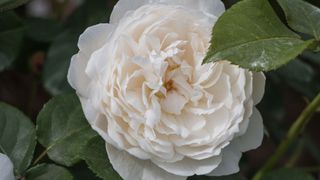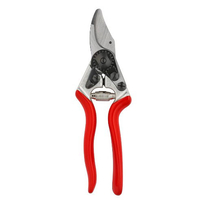What causes spots on roses and how to get rid of them — according to garden experts
Protect your roses from disease

A few days ago, I was delighted to see that the first rose had bloomed on my favorite rose bush. However, when I got a bit closer, I noticed that the shrub’s leaves were speckled with dark spots. Although I was able to admire the beautiful flowers and breathe in their scent, the unattractive leaves let the side down and did not add to the overall aesthetic.
While I knew that roses can be affected by several problems, I hadn’t spotted this issue in my garden before. And, although I’m not new to gardening, I know it’s a problem both novice and experienced gardeners face.
Eager to understand and resolve the issue, I sought the help of some rose experts to discover what was causing the unsightly marks, how to get rid of them, and how to prevent them from returning in the future.
What causes spots on roses?

There are several reasons why roses may develop spots on their leaves. Wes Harvell, Rosarian at Jackson & Perkins, explains that fungal diseases like black spot, powdery mildew or rust can cause them. “These diseases thrive in humid conditions and manifest as dark spots, powdery patches, or rusty-colored growth on the leaves and stems. If not addressed, the black spot disease will rapidly progress throughout the plant, eventually affecting all its parts,” he says.
He explains that as the disease spreads, the plant will shed its leaves, and each infected leaf may serve as a source for further disease transmission. “Despite attempts by the plant to regrow foliage, the new leaves will likely become infected, and the cycle will start over again,” he adds.
As the disease spreads, the plant will shed its leaves, and each infected leaf may serve as a source for further disease transmission.
Roses are one of the common plants that bring bugs into your yard, with pests, such as aphids, spider mites or rose slugs, causing spotting by feeding on the plant tissues. Harvell says, “Identifying the specific symptoms can help determine the exact disease or pest issue.”
Robert Silver, Pro CEO, Pro Gardening Blog, explains more about these insects and what to look out for. “Colonies of pear-shaped green or black aphids clustered on the new shoots are a telltale sign, leaving behind sticky calling cards of honeydew and sooty mould. Their sap-sucking can severely stunt development. Barely visible spider mites also maraud, leaving tiny yellow or bronze specklings from their feasting.”
Sign up to get the BEST of Tom’s Guide direct to your inbox.
Upgrade your life with a daily dose of the biggest tech news, lifestyle hacks and our curated analysis. Be the first to know about cutting-edge gadgets and the hottest deals.
Even if you’ve never experienced issues with your roses before, Harvell warns this may change as temperatures increase. “It’s important to recognize that due to climate changes, diseases are expanding into regions where they were previously absent.”
How to detect black spot, powdery mildew and rust

Black spot: If you notice circular black spots ringed with fringed borders, you’re likely dealing with black spot fungus.
Powdery mildew: This fungal disease can be detected by a powdery white or greyish coating that resembles dust sprinkled over the foliage.
Rust: Marks appear as blackish-brown spots with orange, tan, or yellow centers. The leaf might turn yellow, and if you turn it over, you’ll see orange fungal spores resembling orange powder.
How to correct problems with your roses

If fungal spots appear, Harvell says the first and essential step is to remove and destroy the infected parts of the plants, which will include the leaves and stems. So, grab a pair of the best gardening shears and prune your roses to remove the damaged stems.
He suggests applying an appropriate fungicide once the damaged parts are removed, which will help control the spread and prevent the onset. “For cases of pest-induced spotting, using insecticidal soap or horticultural oils can eradicate pests like aphids, spider mites, or other pests,” he explains.
Silver also suggests the following products are suitable for fungicide use: “Chlorothalonil can help manage black spots and rust, while products containing sulfur or potassium bicarbonate work well on powdery mildew.”
Always check and follow the instructions on the product’s label before using a fungicide.
While regular fungicide application is also key to protecting new growth, Silver also recommends raking up any fallen leaves to further reduce overwintering spores.
Besides the techniques mentioned above, Silver says to make the best use of what nature offers by “promoting beneficial insects that eat annoying rose pests, such as lady beetles and lacewings”.
How to prevent spots on your roses

Preventing future occurrences of spots on your roses involves several measures. Firstly, it begins with the type of roses you grow. Harvell says, “Disease-resistant rose varieties can reduce susceptibility to common fungal diseases.” So, if you are investing in new roses, check their disease-resistance before you buy.
Silver is happy to admit that he preaches about giving roses “good treatment” and stresses that sunlight and airflow are important, and urges you to avoid planting your roses in a dimly lit corner of your yard. “Prune out any dense interior growth so air can circulate freely, as leaves that linger damp are sending invites to mildew and black spot spores.”
Felco No. 6 Pruning Shears: $54.65 @ Amazon
These premium Swiss-made pruning shears are constructed with forged aluminium handles and hardened steel blades, with the added benefit of a wire cutter. The ergonomic handles provides a curved and comfortable hold and are suitable for medium-sized hands.
If your roses are susceptible to black spot, powdery mildew or rust, Harvell suggests establishing a regular schedule using a preventive fungicide treatment. Maintaining proper garden hygiene will also help. “Removing fallen leaves and debris can minimize the presence of fungal spores,” he adds.
Fungal growth can also be discouraged by watering the plants at the base in the morning to allow foliage to dry out during the day. Another method is to apply an organic mulch around the base of the plants to help regulate soil moisture and prevent weed growth, which he says will habor pests. Silver adds, “Roses don’t need daily drinks — a moderate drought is better than a swamp.”
It’s also worth inspecting your roses regularly for early signs of disease or pest infestation, as this will allow for prompt intervention before the problem escalates.
Once the season is over, Silver recommends tidying up. “Cleaning up every last leaf, once winter arrives, will deny diseases and pests a cosy overwintering quarters.” Then, just before the first buds break in spring, he says, “Spray your roses with horticultural oil, as it smooths any fungal stragglers or eggs trying to crash the season’s open party.”
More from Tom's Guide

Camilla Sharman has worked in publishing and marketing for over 30 years and has covered a wide range of sectors within the business and consumer industries both as a feature, content, and freelance writer.
As a business journalist, Camilla has researched articles for many different sectors from the jewellery industry to finance and tech, charities, and the arts. Whatever she’s covered, she enjoys delving deep and learning the ins and out of different topics, then conveying her research within engaging content that informs the reader. In her spare time, when she’s not in her kitchen experimenting with a new recipe, you’ll find her keeping fit at the gym. In the pool, stretching at a yoga class, or on a spin bike, exercise is her escape time. She also loves the great outdoors and if she’s not pottering about in her garden, she’ll be jumping on her bike for a gentle cycle ride.
